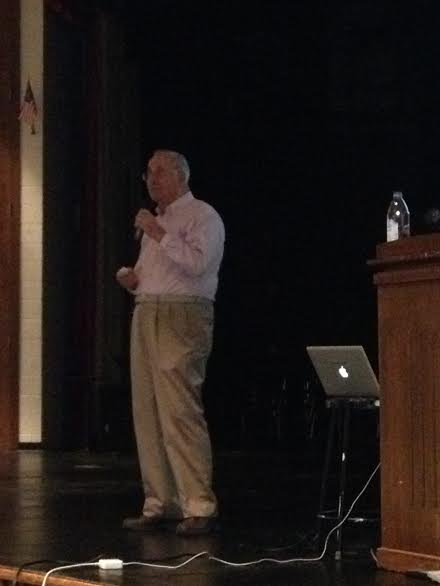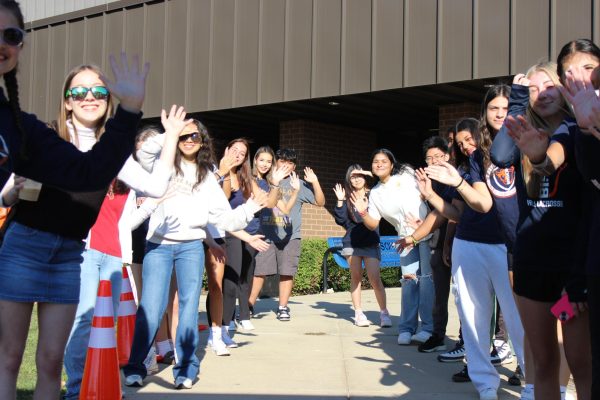Holocaust survivor Steen Metz encourages students to remember

Steen Metz talks to sophomores about his experiences during the Holocaust.
We have learned about Anne Frank, read “The Book Thief” and seen “The Boy in the Striped Pajamas.” From the time we enter fourth grade to the time we graduate, the Holocaust is a subject that will be covered countless times in classrooms. Students equate the word alone to terms like cruelty and terror.
No matter how many movies, books or lessons we encounter about the horrible genocide, nothing is more inspiring and thought provoking than hearing first hand experiences. Last Tuesday, Oct. 21, Steen Metz visited BG for his second time, talking to English classes about his journey.
Metz is a guest speaker and author of “A Danish Boy in Theresienstadt: Reflections of a Holocaust Survivor.” He has held over 100 presentations, reaching about 10,000 students. His message? To remember and share.
“I made it my mission in life to help educate students like yourself,” Metz said. “Yes, the Holocaust did take place. Never forget that. It is important that we continue to talk about it.”
Born in Denmark, only a small percentage of the population was Jewish. When Germany invaded Denmark in 1940, Denmark surrendered, yet things stayed normal for Metz and his family. For the next three years Metz was about to continue going to school and his father was able to practice law.
However, on Oct. 2, 1943, Metz and his family were forced out of his home. He refers to it as “The Fatal Morning.” He was only eight years old.
“The Germans started rounding up the Jews,” Metz said. “I had no idea what was going on. I did not know I was Jewish, I had not been brought up in the Jewish faith. Was it a crime to be Jewish? Of course not. But it is a crime to be Jewish according to Hitler and his regime.”
Metz and his family were directed to boxcars, which were referred to by survivors as “cattle cars.” For three days, they were stuck in the cramped area with no windows, food or bathrooms. They arrived in Czechoslovakia, 550 miles from Denmark, at a camp called Theresienstadt. He stayed at that camp for about two years. His father died of starvation after about six months of enduring grueling work and physical abuse.
Even as a child, Metz worked at the camp. He was a messenger who worked three or four hours a day, delivering papers from one German officer to another. He passed the time playing soccer with Czech boys using a ball made of rags and string.
“One day my friends didn’t show up,” Metz said. “I was quite sad and I told my mother. My mother knew what happened to them, but she didn’t tell me. She wanted to protect me. My friends were sent off to Auschwitz, an extermination camp.”
Theresienstadt was used as the “Model Camp” for the Germans. For one day, everything was clean, the old and frail were hidden, buildings were painted and flowers were planted. On June 23, 1944, doctors came from the Red Cross and Switzerland to evaluate how the Germans were treating the Jews.
“It was one big hoax,” Metz said. “They only went where the German officers wanted to take them. They didn’t see that there was no plumbing or food. It was used as propaganda. The Germans even imported French children into the camp for the day because they looked healthy. The whole thing was a hoax.”
Finally, on April 15, Metz and his mother were liberated by Red Cross buses that took them back to Sweden. Once there, he received tremendous support and reconnected with family who had escaped from Copenhagen. He returned to school and went to a commercial college. He travelled to England, and then Canada where he met his wife before moving to the US. For fifty years he worked for food companies because he wanted to make sure “everyone always had enough to eat.”
“Even after returning home to Denmark with my mother, we did not speak of what had happened,” Metz said. “No survivors did. We all wanted to forget. But I learned to never forget and look forward.”
After many years of living in America, Metz decided it was time to share his story. He wanted to write a novel, giving voices to the thousands of Danes who were taken to camps during the Holocaust. In 2009 he traveled back to Czechoslovakia for the first time since 1945, and all of the memories returned to him.
“Going to Theresienstadt again was one of the most moving experiences I have ever had,” Metz said. “There were memorials with 15,000 names of children who lived in the camp.”
Although going back to those awful years was difficult, it had to be done, according to Metz.
“I didn’t start talking about the Holocaust again until I started researching for my book,” Metz said. “All survivors need to be ready to remember, and I was finally ready to share.”
Since writing the book, Metz has found a passion in public speaking. He encourages students to share what they have heard with others, so the stories of the Holocaust never die.
“I am lucky that I am alive to tell my story,” Metz said. “I lived a very happy life. It is my mission and passion to talk to students, it is very, very important to me. I want you to go home and talk to your family and friends. Today you listened to a survivor and I want you to make sure you spread the message. Talk to at least three people. Together we can spread the stories to hundreds of thousands of people. Never forget so history will not repeat itself.”





